|
Morocco:
West Atlas Bicycle Africa / Ibike Tours |
|||
 |
Marrakech: "Red City" or "Ochre City" | ||
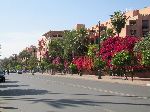 Marrakech
gets its nicknames "Red City" or "Ochre City" from the color of the clay or
paint used to cover many buildings. The colors intensity blend nicely with the
blue sky and is a neutral colored backdrop for the street trees and intense colors
of the bougainvillea and other landscaping. Marrakech
gets its nicknames "Red City" or "Ochre City" from the color of the clay or
paint used to cover many buildings. The colors intensity blend nicely with the
blue sky and is a neutral colored backdrop for the street trees and intense colors
of the bougainvillea and other landscaping.In contrast to the medina (old walled city), the new city has wide streets, straight lines, large traffic circles with fountains and no information street-side economic activity. in a way it is very harmonious and orderly, but can extend into unimaginative and boring. |
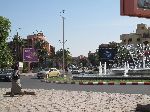 |
||
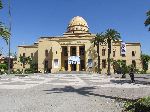 |
Entering Marrakech from the west, there are two prominent buildings a couple kilometers
from the medina; the Royal Theatre (left) and the train station (right). The Theatre,
especially, though new (2001) stands out against of the lack of particularly
interesting architecture in the new parts of the city. The new (2008) railway station seems to be designed to look massive. In the end, it is by-in-large a very large decorated shed. |
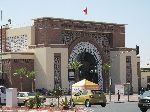 |
|
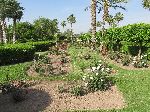 |
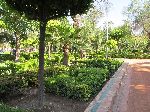
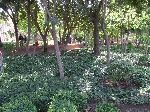 Southwest
of the medina there is a large expanse of connected gardens and parks; Koutoubia
Garden, Cyber Park, Oliveraie and Menara Garden. At the center of Menare is an
artificial lake dating back to the 12th century. It boasts
the first known example of a system of canalization and water distribution. At
one end of the lake stands an elegant Saadian pavilion, completely restored in
the nineteenth century. At dusk the beautiful pyramid of its green-tiled roof,
glimmers golden in the rays of the setting sun. Menara
once served as a royal venue for romantic trysts and is still a great place a
quiet stroll. Southwest
of the medina there is a large expanse of connected gardens and parks; Koutoubia
Garden, Cyber Park, Oliveraie and Menara Garden. At the center of Menare is an
artificial lake dating back to the 12th century. It boasts
the first known example of a system of canalization and water distribution. At
one end of the lake stands an elegant Saadian pavilion, completely restored in
the nineteenth century. At dusk the beautiful pyramid of its green-tiled roof,
glimmers golden in the rays of the setting sun. Menara
once served as a royal venue for romantic trysts and is still a great place a
quiet stroll. |
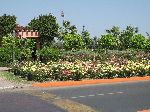 |
|
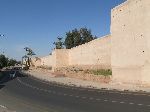 |
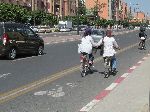
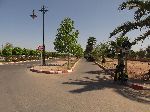 On
some of the boulevards outside the ramparts of the medina there is some bicycle lanes and other bike infrastructure.
The flat topography made for easy bicycling though there are not a great number
of cyclists taking advantage of the facilities, climate, and topography. None the
less, horse-drawn carriages get more attention from the tourists. On
some of the boulevards outside the ramparts of the medina there is some bicycle lanes and other bike infrastructure.
The flat topography made for easy bicycling though there are not a great number
of cyclists taking advantage of the facilities, climate, and topography. None the
less, horse-drawn carriages get more attention from the tourists. |
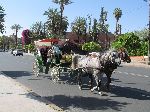 |
|
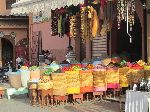 |
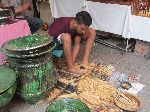 There are two halves of the media: the north part with its dozens of densely
developed souks, residential neighborhoods, and workshops, and the southern part which is
dotted with palaces and other relics of past ruling elite. There are two halves of the media: the north part with its dozens of densely
developed souks, residential neighborhoods, and workshops, and the southern part which is
dotted with palaces and other relics of past ruling elite.This tour starts in
the north. |
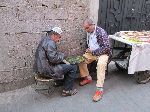 |
|
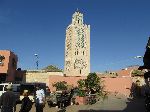 |
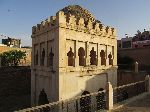 The
center of the souk and residential medina is the majestic Ali ben Youssef
Mosque, built in the 12th century in honor of Sidi Youssef Ben Ali,
one of the seven patron saints of the city. Restoration work carried out in the
16th and 19th centuries has left virtually nothing of the
original structure. But its stone minaret still towers 40 meters above the
varnished tiles of the city’s rooftops. The
center of the souk and residential medina is the majestic Ali ben Youssef
Mosque, built in the 12th century in honor of Sidi Youssef Ben Ali,
one of the seven patron saints of the city. Restoration work carried out in the
16th and 19th centuries has left virtually nothing of the
original structure. But its stone minaret still towers 40 meters above the
varnished tiles of the city’s rooftops. |
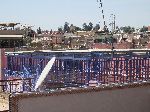 |
|
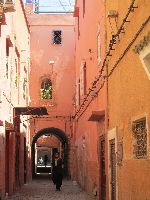 |
|
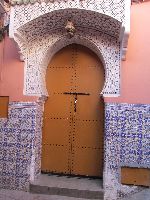 |
|
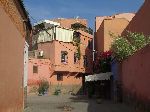 |
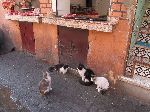
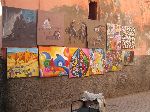
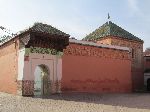
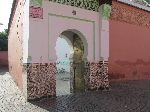 |
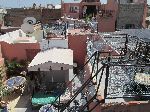 |
|
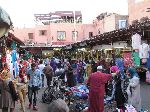 |
Around Morocco, the reputation of Marrakech is it is all about business. Outside of Marrakech, it doesn't really matter what town, if you have come from Marrakech, they are proud to tell you that their town is friendlier. It is not that Marrakech is hostile, but money never seems to be very far from most interactions. This is manifest in its miles of shop-lined streets and dozens of market squares that are packed with goods and people from mid-morning until sunset. If crowds and aggressive vendors are not your cup of tea, an early morning stroll through the souk is very pleasant. |
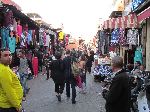 |
|
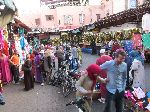 |
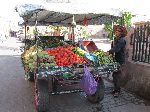
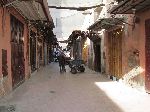
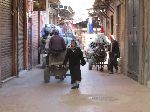
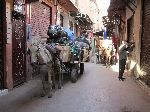 |
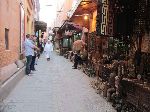 |
|
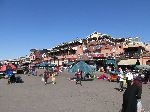 |
The crescendo for Djemma el-Fna is a couple hours after dark. About
mid-morning the plaza
comes to life with fruit and spice sellers, Guerrab (water sellers) with
their leather water-skins and metal cups, barbers, henna tattoo artists, games of chance, magicians and a host of other hawkers,
hustlers, |
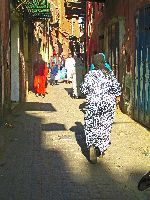 |
|
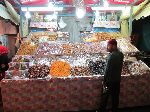 |
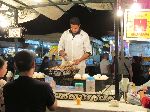
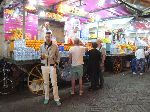
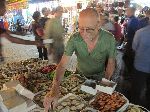
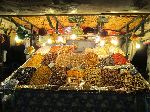 |
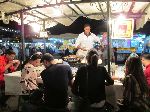 |
|
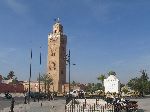 |
West of Djemma el-Fna is Koutoubia Mosque and it prominent minaret. One of
the values of the visibility of the minaret is if you get lost and can see the
minaret, you get make you way back to it and then back to Djemma el-Fna -- day
or night -- and hopefully from there, reorient yourself. Unfortunately for
the untrained eye, there are several other minarets in Marrakech that are not
too dissimilar from Koutoubia so it can be confusing.
The Koutoubia is one of the largest mosques in the Western Islamic world and considered one of the most beautiful in the harmonious unity of its design. The "booksellers’ mosque" owes its name to the manuscript souk whose shops were attached to its walls during the Middle Ages, a practice common in Arab Muslim towns. It stands as a permanent example of the Hispanic-Moorish art of the Almohad era. One commentary notes, the builders "allying apparent simplicity with marvelous dexterity and discreet luxury. It's renowned minaret, a jewel of Hispanic-Moorish architecture, has cast its protective shadow over the city for more than eight centuries." |
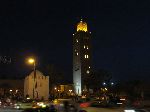 |
|
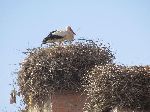
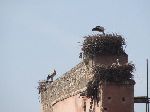 One
has to wonder where the storks nested before humans built and abandoned city
walls. The don't seem to mind being near urban hustle and bustle, but the seem
to be a calculation to keep themselves out of reach. This series of photos was
taken with a telephoto lens. One
has to wonder where the storks nested before humans built and abandoned city
walls. The don't seem to mind being near urban hustle and bustle, but the seem
to be a calculation to keep themselves out of reach. This series of photos was
taken with a telephoto lens. |
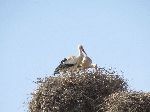 |
||
|
|
|||
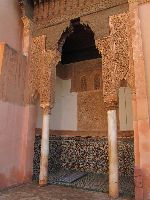 |
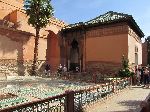
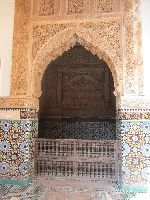 Saadian
Tombs, In 1591 work was begun in the south
of the Kasbah on the Marrakech Necropolis with the building of the first koubba
(dome), which was to contain the tombs of the ancestors of the Saadian
Sultan, Ahmed El-Mansour. Saadian princes had been buried here as early as
1557, mausoleums were built in the 16th century to house the
sepulchers of thirteen sovereigns. The delicacy and elegance of decoration, and
variety of treatments, in
harmony with the purity of its architectural lines, and secret garden, makes the mausoleum an
exceptional work. When Moulay Ismael took the city in 1677, and want to obscure
his predecessors, had a wall built around the tombs. It worked for 240 years
when the mausoleums were rediscovered in 1917 from an aerial photo. Saadian
Tombs, In 1591 work was begun in the south
of the Kasbah on the Marrakech Necropolis with the building of the first koubba
(dome), which was to contain the tombs of the ancestors of the Saadian
Sultan, Ahmed El-Mansour. Saadian princes had been buried here as early as
1557, mausoleums were built in the 16th century to house the
sepulchers of thirteen sovereigns. The delicacy and elegance of decoration, and
variety of treatments, in
harmony with the purity of its architectural lines, and secret garden, makes the mausoleum an
exceptional work. When Moulay Ismael took the city in 1677, and want to obscure
his predecessors, had a wall built around the tombs. It worked for 240 years
when the mausoleums were rediscovered in 1917 from an aerial photo. |
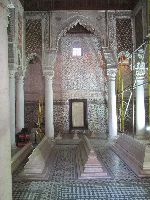 |
|
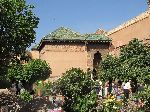 |
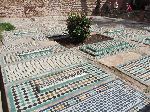
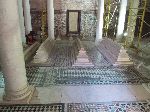
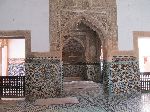
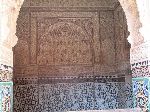 |
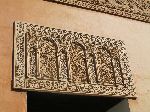 |
|
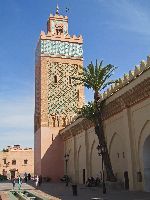 Adjacent to the Saadian Tombs is the
El-Mansour Mosque (apparently also referred to as the Moulay el Yazid Mosque
and Kasbah Mosque). It was
built in the 12th century during the reign of Sultan Yacoub El-Mansour.
Following the explosion in 1569, the mosque was restored bit by bit and was
renamed the Mosque of the Golden Apples in the 16th century. Legend
has it that, like their counterparts atop the nearby Koutoubia, the globes
crowning the lantern of its minaret, were fashioned from the jewelry belonging
to Sultan Yacoub El-Mansour’s wife. Beautiful and grandiose at the same time,
the layout and decor of this majestic mosque have remained a model of classical
architecture down the centuries. Adjacent to the Saadian Tombs is the
El-Mansour Mosque (apparently also referred to as the Moulay el Yazid Mosque
and Kasbah Mosque). It was
built in the 12th century during the reign of Sultan Yacoub El-Mansour.
Following the explosion in 1569, the mosque was restored bit by bit and was
renamed the Mosque of the Golden Apples in the 16th century. Legend
has it that, like their counterparts atop the nearby Koutoubia, the globes
crowning the lantern of its minaret, were fashioned from the jewelry belonging
to Sultan Yacoub El-Mansour’s wife. Beautiful and grandiose at the same time,
the layout and decor of this majestic mosque have remained a model of classical
architecture down the centuries. |
|||
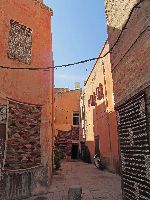 |
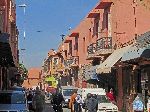 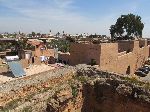 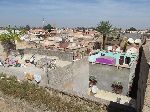 Views of
some streets and a rooftop perspective of the Kasbah section of Marrakech, between the
El-Mansour Mosque and El Badi palace. Views of
some streets and a rooftop perspective of the Kasbah section of Marrakech, between the
El-Mansour Mosque and El Badi palace. |
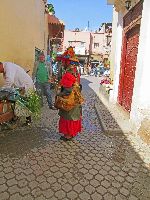 |
|
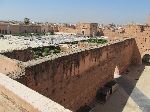 |
 The
building of the vast and opulent El Badi Palace was ordered by the newly anointed sultan,
Ahmed El-Mansour, in 1578, following the Moroccan victory
over the Portuguese at the famous and pivotal Battle of the Three Kings*.
El-Mansour would go on to prove himself to be one of the strongest leaders in
Moroccan history. The
building of the vast and opulent El Badi Palace was ordered by the newly anointed sultan,
Ahmed El-Mansour, in 1578, following the Moroccan victory
over the Portuguese at the famous and pivotal Battle of the Three Kings*.
El-Mansour would go on to prove himself to be one of the strongest leaders in
Moroccan history.Designed to host magnificent receptions and banquets, it counted three hundred and sixty rooms arranged around a large inner courtyard adorned with a pool and blooming flowerbeds. The interior decorating featured abundant trappings were made of gold, crystal, and turquoise. Now, to visualize this takes a vivid imagination. The palace was pillaged in 1696 by order of Moulay Ismael to provide decoration for his royal palaces in Meknes, only the shell of this once resplendent edifice remains. The line of a dozen storks hanging out on the top of the ramparts are making the best of that. * The battle took place near Ksar el Kebir (110km south of Tangiers and 160km north of Rabat). The three kings involved were King Sebastian of Portugal, the ruling sultan of Morocco, Abd el-Malik and the deposed sultan, Muhammad. Sebastian's aim was to start a crusade in Morocco, in order to bring the country under Christian rule. Al-Mutawakkil hoped to be returned to reestablish himself as the Sultan. It was a route for the Moroccans, but all three kings, including Abd el-Malik, died in the course of the battle. |
 |
|
  Working
our way counter-clock-wise around the southern end of the medina is the Mellah
-- the tradition Jewish quarter of a Moroccan town. Mellah generally features
very narrow streets and Marrakech's has particularly high buildings. Working
our way counter-clock-wise around the southern end of the medina is the Mellah
-- the tradition Jewish quarter of a Moroccan town. Mellah generally features
very narrow streets and Marrakech's has particularly high buildings.About the only indication that it was once a thriving Jewish community is an old Synagogue and a few streets that are named after Rabbis, that have kept there names. |
|||

  Most of the
Jewish community emigrated in the decade after independence. The most
interesting feature that still remains is the spice and herb market, apothecary
shops, and artisans market, just outside the Mellah. Most of the
Jewish community emigrated in the decade after independence. The most
interesting feature that still remains is the spice and herb market, apothecary
shops, and artisans market, just outside the Mellah. |
 |
||
 |



 |
 |
|
 |
Bahia Palace is sumptuous residence built at the end of the 19th
century by order of Ba Ahmed. Set in an immense eight-hectare garden, the
property contains a haphazard succession of luxurious secret apartments opening
onto gardens and patios. A thousand craftsmen, for the most part from the Fez
region, took part in its construction which took over seven years. The building
of the palace reintroduced the techniques and decorative materials of
traditional architecture. As for the elite of centuries earlier, carved wood and
sculpted plasterwork and stucco adorn its interiors and exteriors. The
craftsmanship of almost every detail from floor to ceiling, in every room, is
impressive.
[The background border on this section is from tile work at Bahai Palace.] |
 |
|
 |



 |
 |
|
|
|
|||
|
|
Unique Programs To Special Places For Memories Of A Lifetime!
"Hosted by
DreamHost - earth friendly web hosting"
|
|










